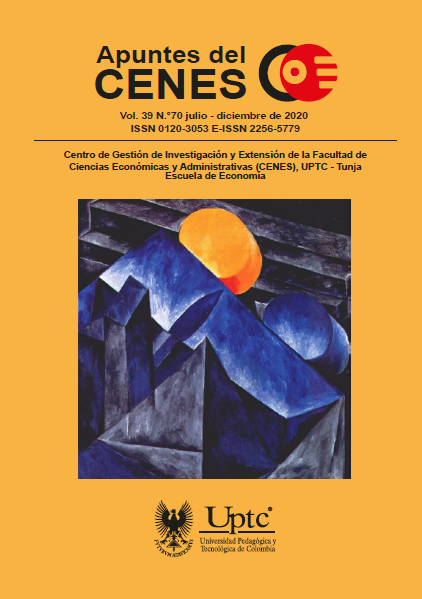El impuesto sobre la renta empresarial en Colombia: su tasa efectiva y su relación con la inversión

Resumen
En Colombia es tradicional que cuando se trata de emprender reformas tributarias, se indique también la necesidad de promover la inversión y el crecimiento económico, de modo que se recurre a fórmulas como la reducción de las alícuotas del impuesto sobre la renta empresarial (ISRE) y la creación de beneficios tributarios. Este trabajo revisa los postulados tras la reforma tributaria de 2018 en Colombia, conocida como Ley de Financiamiento, para mostrar, primero, que la tasa efectiva asociada al ISRE no es muy alta, para lo cual se consideran los datos agregados de las declaraciones tributarias de la Dirección de Impuestos y Aduanas Nacionales para el año 2016. En segundo lugar, y a través de un ejercicio econométrico basado en un panel de datos que incluye observaciones para 109 países (dada la insuficiencia de datos para considerar solo a Colombia) durante el periodo 2006-2015, se establece que estadísticamente no hay evidencia de una relación entre impuestos corporativos e inversión.
Palabras clave
impuesto sobre la renta empresarial; inversión; inversión extranjera directa; tasa efectiva de tributación; Ley de Financiamiento;
Referencias
1. Adam, A., Kammas, P. & Lagou, A. (2013). The Effect of Globalization on Capital Taxation: What Have we Learned After 20 Years of Empirical Studies? Journal of Macroeconomics, 35, 199-209. https://doi.org/10.1016/j.jmacro.2012.09.003
2. Agostini, C. & Jalile, I. (2009). Efectos de los impuestos corporativos en la inversión extranjera en América Latina. Latin American Research Review, 44(2), 84-108. https://doi.org/10.1353/lar.0.0127
3. Alm, J. (1996). What is an Optimal Tax System. National Tax Journal , 49(1), 117-133.
4. Arellano, M. & Bond, S. (1991). Some Tests of Specification for Panel Data: Monte Carlo Evidence and an Application to Employment Equations. The Review of Economic Studies, 58 (2), 277–297. https://doi.org/10.2307/2297968
5. Atkinson, A. & Stiglitz, J. (2015). Lectures on Public Economics. Princeton University Press.
6. Banco Mundial. (2018). Global Investment Competitiveness Report 2017/2018: Foreign Investor Perspectives and Policy Implications. World Bank.
7. Beck, N. & Katz, J. (1995). What to do (and not to do) with Time-Series Cross-Section Data. American Political Science Review, 89(3), 634-647. https://doi.org/10.2307/2082979
8. Bokpin, A., Mensah, L. & Asemoah, M. (2015). Foreign Direct Investment and Natural Resources in Africa. Journal of Economic Studies, 42(4), 608-621. https://doi.org/10.1108/JES-01-2014-0023
9. Castañeda-Rodríguez, V. (2016). Las crisis económicas y el escenario político en la introducción de reformas tributarias. La experiencia argentina (1980-2010) y una constatación para América Latina. Cuadernos de Economía, 35(67), 173-206. https://doi.org/10.15446/cuad.econ.v35n67.52466
10. Castañeda-Rodríguez, V. (2019). The 2016 Tax Reform in Colombia: a Patchwork Quilt. Cuadernos de Administración, 35(65), 72-91. https://doi.org/10.25100/cdea.v35i65.7676
11. Chanegriha, M., Stewart, C. & Tsoukis, C. (2017). Identifying the Robust Economic, Geographical and Political Determinants of FDI: An Extreme Bounds Analysis. Empirical Economics, 52(2), 759–776. https://doi.org/10.1007/s00181-016-1097-1
12. Doing Business. (2019, April 27). Doing Business. http://www.doingbusiness.org/en/data/exploreeconomies/colombia#DB_tax
13. García, A. (2016, 7 mar.). Los altos impuestos son un suicidio para la economía. El País, p. 18.
14. Gómez, H. & Steiner, R. (2015). La reforma tributaria y su impacto sobre la tasa efectiva de tributación de las firmas en Colombia. Coyuntura Económica: Investigación Económica y Social, 45(1), 13-44.
15. Hunady, J. & Orviska, M. (2014). Determinants of Foreign Direct Investment in EU Countries. Do Corporate Taxes Really Matter? Procedia Economics and Finance, 12, 243-250. https://doi.org/10.1016/S2212-5671(14)00341-4
16. Jiménez, J. & Podestá, A. (2009). Inversión, incentivos fiscales y gastos tributarios en América Latina. CEPAL.
17. Ministerio de Hacienda y Crédito Público (2018, 31 de oct.). Exposición de motivos del proyecto de ley “por la cual se expiden normas de financiamiento para el restablecimiento del equilibrio del presupuesto nacional y se dictan otras disposiciones”. MHCP.
18. Rincón-Castro, H. & Delgado-Rojas, M. E. (2018) ¿Cuánto tributan efectivamente el consumo, el trabajo y el capital en Colombia? Reportes del Emisor, 229, 5. https://doi.org/10.32468/be.1041
19. Villabona, J. & Quimbay, C. (2017). Tasas efectivas del impuesto de renta para sectores de la economía colombiana entre el 2000 y el 2015. Innovar, 27(66), 91-108. https://doi.org/10.15446/innovar.v27n66.66805
20. Villaverde, J. & Maza, A. (2015). The Determinants of Inward Foreign Direct Investment: Evidence from the European Regions. International Business Review, 24(2), 209-223. https://doi.org/10.1016/j.ibusrev.2014.07.008
